Permafrost
Permafrost is ground that continuously remains below 0 °C (32 °F) for two or more years, located on land or under the ocean. Most common in the Northern Hemisphere, around 15% of the Northern Hemisphere or 11% of the global surface is underlain by permafrost,[1] with the total area of around 18 million km2.[2] This includes substantial areas of Alaska, Greenland, Canada and Siberia. It can also be located on mountaintops in the Southern Hemisphere and beneath ice-free areas in the Antarctic.
| Permafrost | |
|---|---|
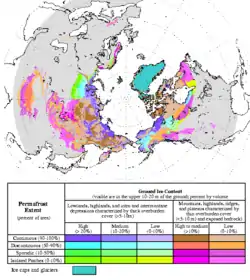 Map showing extent and types of permafrost in the Northern Hemisphere | |
| Used in | International Permafrost Association |
| Climate | High latitudes, alpine regions |
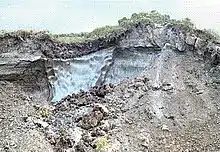
Permafrost does not have to be the first layer that is on the ground. It can be from an inch to several miles deep under the Earth's surface. It frequently occurs in ground ice, but it can also be present in non-porous bedrock. Permafrost is formed from ice holding various types of soil, sand, and rock in combination.[3]
Permafrost contains large amounts of biomass and decomposed biomass that has been stored as methane and carbon dioxide, making tundra soil a carbon sink. As global warming heats the ecosystem and causes soil thawing, the permafrost carbon cycle accelerates and releases much of these soil-contained greenhouse gases into the atmosphere, creating a feedback cycle that increases climate change.[4] Thawing of permafrost is one of the effects of climate change. The Sixth IPCC Report states that while emissions from thawing permafrost will be significant enough to lead to additional warming, they will likely not be enough to trigger a self-reinforcing feedback leading to runaway warming.[5]
Study of permafrost

In contrast to the relative dearth of reports on frozen ground in North America prior to World War II, a vast literature on basic permafrost science and the engineering aspects of permafrost was available in Russian. Some Russian authors relate permafrost research with the name Alexander von Middendorff (1815–1894). However, Russian scientists also realized, that Karl Ernst von Baer must be given the attribute "founder of scientific permafrost research". In 1843, Baer's original study “materials for the study of the perennial ground-ice” was ready to be printed. Baer's detailed study consists of 218 pages and was written in German language, as he was a Baltic German scientist. He was teaching at the University of Königsberg and became a member of the St Petersburg Academy of Sciences. This world's first permafrost textbook was conceived as a complete work and ready for printing in 1843. But it remained lost for around 150 years. However, from 1838 onwards, Baer published several individual publications on permafrost. The Russian Academy of Sciences honoured Baer with the publication of a tentative Russian translation of his study in 1942.
These facts were completely forgotten after the Second World War. Thus in 2001 the discovery of the typescript from 1843 in the library archives of the University of Giessen and its annotated publication was a scientific sensation. The full text of Baer's original work is available online (234 pages).[6] The editor added to the facsimile reprint a preface in English, two colour permafrost maps of Eurasia and some figures of permafrost features. Baer's text is introduced with detailed comments and references on additional 66 pages written by the Estonian historian Erki Tammiksaar. The work is fascinating to read, because both Baer's observations on permafrost distribution and his periglacial morphological descriptions are largely still correct today. With his compilation and analysis of all available data on ground ice and permafrost, Baer laid the foundation for the modern permafrost terminology. Baer's southern limit of permafrost in Eurasia drawn in 1843 corresponds well with the actual southern limit on the Circum-Arctic Map of Permafrost and Ground Ice Conditions of the International Permafrost Association (edited by J. Brown et al.).
Beginning in 1942, Siemon William Muller delved into the relevant Russian literature held by the Library of Congress and the U.S. Geological Survey Library so that he was able to furnish the government an engineering field guide and a technical report about permafrost by 1943",[7] the year in which he coined the term as a contraction of permanently frozen ground.[8] Although originally classified (as U.S. Army. Office of the Chief of Engineers, Strategic Engineering Study, no. 62, 1943),[8][9][10][11] in 1947 a revised report was released publicly, which is regarded as the first North American treatise on the subject.[7][11]
Classification and extent
.jpg.webp)
Permafrost is soil, rock or sediment that is frozen for more than two consecutive years. In areas not covered by ice, it exists beneath a layer of soil, rock or sediment, which freezes and thaws annually and is called the "active layer".[12] In practice, this means that permafrost occurs at an mean annual temperature of −2 °C (28.4 °F) or below. Active layer thickness varies with the season, but is 0.3 to 4 meters thick (shallow along the Arctic coast; deep in southern Siberia and the Qinghai-Tibetan Plateau).
The extent of permafrost is displayed in terms of permafrost zones, which are defined according to the area underlain by permafrost as continuous (90%–100%), discontinuous (50%–90%), sporadic (10%–50%), and isolated patches (10% or less).[13] These permafrost zones cover together approximately 22% of the Northern Hemisphere. Continuous permafrost zone covers slightly more than half of this area, discontinuous permafrost around 20 percent, and sporadic permafrost together with isolated patches little less than 30 percent.[14] Because permafrost zones are not entirely underlain by permafrost, only 15% of the ice-free area of the Northern Hemisphere is actually underlain by permafrost.[1] Most of this area is found in Siberia, northern Canada, Alaska and Greenland. Beneath the active layer annual temperature swings of permafrost become smaller with depth. The deepest depth of permafrost occurs where geothermal heat maintains a temperature above freezing. Above that bottom limit there may be permafrost with a consistent annual temperature—"isothermal permafrost".[15]
Continuity of coverage
Permafrost typically forms in any climate where the mean annual air temperature is lower than the freezing point of water. Exceptions are found in humid boreal forests, such as in Northern Scandinavia and the North-Eastern part of European Russia west of the Urals, where snow acts as an insulating blanket. Glaciated areas may also be exceptions. Since all glaciers are warmed at their base by geothermal heat, temperate glaciers, which are near the pressure-melting point throughout, may have liquid water at the interface with the ground and are therefore free of underlying permafrost.[16] "Fossil" cold anomalies in the Geothermal gradient in areas where deep permafrost developed during the Pleistocene persist down to several hundred metres. This is evident from temperature measurements in boreholes in North America and Europe.[17]
Discontinuous permafrost
The below-ground temperature varies less from season to season than the air temperature, with mean annual temperatures tending to increase with depth as a result of the geothermal crustal gradient. Thus, if the mean annual air temperature is only slightly below 0 °C (32 °F), permafrost will form only in spots that are sheltered—usually with a northern or southern aspect (in north and south hemispheres respectively) —creating discontinuous permafrost. Usually, permafrost will remain discontinuous in a climate where the mean annual soil surface temperature is between −5 and 0 °C (23 and 32 °F). In the moist-wintered areas mentioned before, there may not be even discontinuous permafrost down to −2 °C (28 °F). Discontinuous permafrost is often further divided into extensive discontinuous permafrost, where permafrost covers between 50 and 90 percent of the landscape and is usually found in areas with mean annual temperatures between −2 and −4 °C (28 and 25 °F), and sporadic permafrost, where permafrost cover is less than 50 percent of the landscape and typically occurs at mean annual temperatures between 0 and −2 °C (32 and 28 °F).[18] In soil science, the sporadic permafrost zone is abbreviated SPZ and the extensive discontinuous permafrost zone DPZ.[19] Exceptions occur in un-glaciated Siberia and Alaska where the present depth of permafrost is a relic of climatic conditions during glacial ages where winters were up to 11 °C (20 °F) colder than those of today.
Continuous permafrost
| Locality | Area |
|---|---|
| Qinghai-Tibet Plateau | 1,300,000 km2 (500,000 sq mi) |
| Khangai-Altai Mountains | 1,000,000 km2 (390,000 sq mi) |
| Brooks Range | 263,000 km2 (102,000 sq mi) |
| Siberian Mountains | 255,000 km2 (98,000 sq mi) |
| Greenland | 251,000 km2 (97,000 sq mi) |
| Ural Mountains | 125,000 km2 (48,000 sq mi) |
| Andes | 100,000 km2 (39,000 sq mi) |
| Rocky Mountains (US and Canada) | 100,000 km2 (39,000 sq mi) |
| Alps | 80,000 km2 (31,000 sq mi) |
| Fennoscandian mountains | 75,000 km2 (29,000 sq mi) |
| Remaining | <50,000 km2 (19,000 sq mi) |
At mean annual soil surface temperatures below −5 °C (23 °F) the influence of aspect can never be sufficient to thaw permafrost and a zone of continuous permafrost (abbreviated to CPZ) forms. A line of continuous permafrost in the Northern Hemisphere[21] represents the most southern border where land is covered by continuous permafrost or glacial ice. The line of continuous permafrost varies around the world northward or southward due to regional climatic changes. In the southern hemisphere, most of the equivalent line would fall within the Southern Ocean if there were land there. Most of the Antarctic continent is overlain by glaciers, under which much of the terrain is subject to basal melting.[22] The exposed land of Antarctica is substantially underlain with permafrost,[23] some of which is subject to warming and thawing along the coastline.[24]
Alpine permafrost
Alpine permafrost occurs at elevations with low enough average temperatures to sustain perennially frozen ground; much alpine permafrost is discontinuous.[25] Estimates of the total area of alpine permafrost vary. Bockheim and Munroe[20] combined three sources and made the tabulated estimates by region, totaling 3,560,000 km2 (1,370,000 sq mi).
Alpine permafrost in the Andes has not been mapped.[26] Its extent has been modeled to assess the amount of water bound up in these areas.[27] In 2009, a researcher from Alaska found permafrost at the 4,700 m (15,400 ft) level on Africa's highest peak, Mount Kilimanjaro, approximately 3° south of the equator.[28]
Subsea permafrost
Subsea permafrost occurs beneath the seabed and exists in the continental shelves of the polar regions.[29] These areas formed during the last ice age, when a larger portion of Earth's water was bound up in ice sheets on land and when sea levels were low. As the ice sheets melted to again become seawater, the permafrost became submerged shelves under relatively warm and salty boundary conditions, compared to surface permafrost. Therefore, subsea permafrost exists in conditions that lead to its diminishment. According to Osterkamp, subsea permafrost is a factor in the "design, construction, and operation of coastal facilities, structures founded on the seabed, artificial islands, sub-sea pipelines, and wells drilled for exploration and production."[30] It also contains gas hydrates in places, which are a "potential abundant source of energy" but may also destabilize as subsea permafrost warms and thaws, producing large amounts of methane gas, which is a potent greenhouse gas.[30][31][32] Scientists report with high confidence that the extent of subsea permafrost is decreasing, and 97% of permafrost under Arctic ice shelves is currently thinning.[33][34]
Manifestations
| Time (yr) | Permafrost depth |
|---|---|
| 1 | 4.44 m (14.6 ft) |
| 350 | 79.9 m (262 ft) |
| 3,500 | 219.3 m (719 ft) |
| 35,000 | 461.4 m (1,514 ft) |
| 100,000 | 567.8 m (1,863 ft) |
| 225,000 | 626.5 m (2,055 ft) |
| 775,000 | 687.7 m (2,256 ft) |
Base depth
Permafrost extends to a base depth where geothermal heat from the Earth and the mean annual temperature at the surface achieve an equilibrium temperature of 0 °C.[36] The base depth of permafrost reaches 1,493 m (4,898 ft) in the northern Lena and Yana River basins in Siberia.[37] The geothermal gradient is the rate of increasing temperature with respect to increasing depth in the Earth's interior. Away from tectonic plate boundaries, it is about 25–30 °C/km (124–139 °F/mi) near the surface in most of the world.[38] It varies with the thermal conductivity of geologic material and is less for permafrost in soil than in bedrock.[36]
Calculations indicate that the time required to form the deep permafrost underlying Prudhoe Bay, Alaska was over a half-million years.[35][39] This extended over several glacial and interglacial cycles of the Pleistocene and suggests that the present climate of Prudhoe Bay is probably considerably warmer than it has been on average over that period. Such warming over the past 15,000 years is widely accepted.[35] The table to the right shows that the first hundred metres of permafrost forms relatively quickly but that deeper levels take progressively longer.
Massive ground ice
.png.webp)
When the ice content of a permafrost exceeds 250 percent (ice to dry soil by mass) it is classified as massive ice. Massive ice bodies can range in composition, in every conceivable gradation from icy mud to pure ice. Massive icy beds have a minimum thickness of at least 2 m and a short diameter of at least 10 m.[40] First recorded North American observations were by European scientists at Canning River, Alaska in 1919.[41] Russian literature provides an earlier date of 1735 and 1739 during the Great North Expedition by P. Lassinius and Kh. P. Laptev, respectively.[42] Two categories of massive ground ice are buried surface ice and intrasedimental ice[43] (also called constitutional ice).[42]
Buried surface ice may derive from snow, frozen lake or sea ice, aufeis (stranded river ice) and—probably the most prevalent—buried glacial ice.[44]
Intrasedimental ice forms by in-place freezing of subterranean waters and is dominated by segregational ice which results from the crystallizational differentiation taking place during the freezing of wet sediments, accompanied by water migrating to the freezing front.[42]
Intrasedimental or constitutional ice has been widely observed and studied across Canada and also includes intrusive and injection ice.[41][42]
Additionally, ice wedges—a separate type of ground ice—produce recognizable patterned ground or tundra polygons. Ice wedges form in a pre-existing geological substrate and were first described in 1919.[41][42]

Landforms
Permafrost processes manifest themselves in large-scale land forms, such as palsas and pingos[45] and smaller-scale phenomena, such as patterned ground found in arctic, periglacial and alpine areas.[46] In ice-rich permafrost areas, melting of ground ice initiates thermokarst landforms such as thermokarst lakes, thaw slumps, thermal-erosion gullies, and active layer detachments.[47][48]
 A group of palsas, as seen from above, formed by the growth of ice lenses.
A group of palsas, as seen from above, formed by the growth of ice lenses.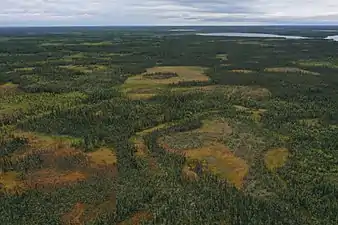 A peat plateau complex south of Fort Simpson, Northwest Territories
A peat plateau complex south of Fort Simpson, Northwest Territories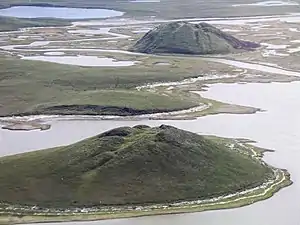 Pingos near Tuktoyaktuk, Northwest Territories, Canada
Pingos near Tuktoyaktuk, Northwest Territories, Canada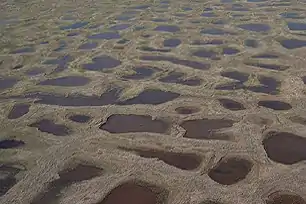 Ground polygons
Ground polygons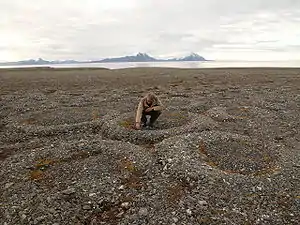 Stone rings on Spitsbergen
Stone rings on Spitsbergen Ice wedges seen from top
Ice wedges seen from top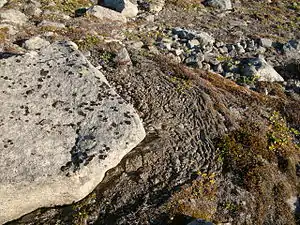 Solifluction on Svalbard
Solifluction on Svalbard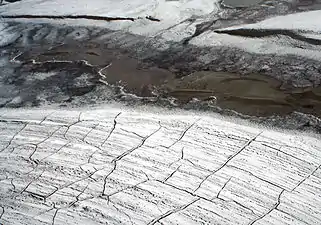 Contraction crack (ice wedge) polygons on Arctic sediment.
Contraction crack (ice wedge) polygons on Arctic sediment.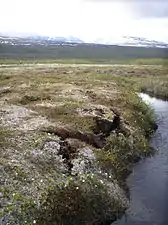 Cracks forming at the edges of the Storflaket permafrost bog in Sweden.
Cracks forming at the edges of the Storflaket permafrost bog in Sweden.
Carbon cycle in permafrost
The permafrost carbon cycle (Arctic Carbon Cycle) deals with the transfer of carbon from permafrost soils to terrestrial vegetation and microbes, to the atmosphere, back to vegetation, and finally back to permafrost soils through burial and sedimentation due to cryogenic processes. Some of this carbon is transferred to the ocean and other portions of the globe through the global carbon cycle. The cycle includes the exchange of carbon dioxide and methane between terrestrial components and the atmosphere, as well as the transfer of carbon between land and water as methane, dissolved organic carbon, dissolved inorganic carbon, particulate inorganic carbon and particulate organic carbon.[49]
Effects of climate change
Arctic permafrost has been diminishing for decades. Globally, permafrost warmed by about 0.3 °C between 2007 and 2016, with stronger warming observed in the continuous permafrost zone relative to the discontinuous zone.[50] The consequence is thawing soil, which may be weaker, and release of methane, which contributes to an increased rate of global warming as part of a feedback loop caused by microbial decomposition.[51][52] Wetlands drying out from drainage or evaporation compromises the ability of plants and animals to survive.[51] When permafrost continues to diminish, many climate change scenarios will be amplified. In areas where permafrost is high, nearby human infrastructure may be damaged severely by the thawing of permafrost.[53][54] It is believed that carbon storage in permafrost globally is approximately 1600 gigatons; equivalent to twice the atmospheric pool.[55]
Historical changes
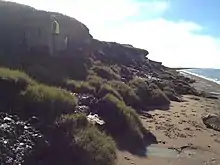
At the Last Glacial Maximum, continuous permafrost covered a much greater area than it does today, covering all of ice-free Europe south to about Szeged (southeastern Hungary) and the Sea of Azov (then dry land)[56] and East Asia south to present-day Changchun and Abashiri.[57] In North America, only an extremely narrow belt of permafrost existed south of the ice sheet at about the latitude of New Jersey through southern Iowa and northern Missouri, but permafrost was more extensive in the drier western regions where it extended to the southern border of Idaho and Oregon.[58] In the southern hemisphere, there is some evidence for former permafrost from this period in central Otago and Argentine Patagonia, but was probably discontinuous, and is related to the tundra. Alpine permafrost also occurred in the Drakensberg during glacial maxima above about 3,000 metres (9,840 ft).[59][60]
Thaw
By definition, permafrost is ground that remains frozen for two or more years.[3] The ground can consist of many substrate materials, including bedrock, sediment, organic matter, water or ice. Frozen ground is that which is below the freezing point of water, whether or not water is present in the substrate. Ground ice is not always present, as may be the case with nonporous bedrock, but it frequently occurs and may be present in amounts exceeding the potential hydraulic saturation of the thawed substrate.
During thaw, the ice content of the soil melts and, as the water drains or evaporates, causes the soil structure to weaken and sometimes become viscous until it regains strength with decreasing moisture content. Thawing can also influence the rate of change of soil gases with the atmosphere.[61] One visible sign of permafrost degradation is the random displacement of trees from their vertical orientation in permafrost areas.[62]
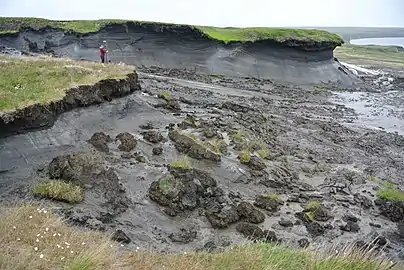 Thawing permafrost in Herschel Island, Canada, 2013
Thawing permafrost in Herschel Island, Canada, 2013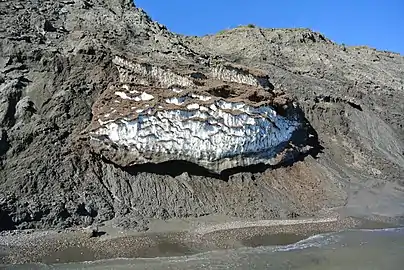 Permafrost and ice in Herschel Island, Canada, 2012
Permafrost and ice in Herschel Island, Canada, 2012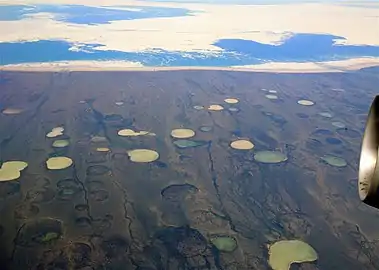 Permafrost thaw ponds on peatland in Hudson Bay, Canada in 2008.[63]
Permafrost thaw ponds on peatland in Hudson Bay, Canada in 2008.[63]
Effect on slope stability
Over the past century, an increasing number of alpine rock slope failure events in mountain ranges around the world have been recorded. It is expected that the high number of structural failures is due to permafrost thawing, which is thought to be linked to climate change. Permafrost thawing is thought to have contributed to the 1987 Val Pola landslide that killed 22 people in the Italian Alps.[64] In mountain ranges, much of the structural stability can be attributed to glaciers and permafrost. As climate warms, permafrost thaws, which results in a less stable mountain structure, and ultimately more slope failures.[65]
McSaveney[66] reported massive rock and ice falls (up to 11.8 million m3), earthquakes (up to 3.9 Richter), floods (up to 7.8 million m3 water), and rapid rock-ice flow to long distances (up to 7.5 km at 60 m/s) caused by “instability of slopes” in high mountain permafrost. Instability of slopes in permafrost at elevated temperatures near freezing point in warming permafrost is related to effective stress and buildup of pore-water pressure in these soils.[67] Kia and his co-inventors[68] invented a new filter-less rigid piezometer (FRP) for measuring pore-water pressure in partially frozen soils such as warming permafrost soils. They extended the use of effective stress concept to partially frozen soils for use in slope stability analysis of warming permafrost slopes. The use of effective stress concept has many advantages such as ability to extend the concepts of "Critical State Soil Mechanics" into frozen ground engineering.
In high mountains rockfalls may be caused by thawing of rock masses with permafrost.[69]
Frozen debris lobes
According to the University of Alaska Fairbanks, frozen debris lobes (FDLs) are "slow-moving landslides composed of soil, rocks, trees, and ice that occur in permafrost.[70] As of December 2021, there were 43 frozen debris lobes identified in the southern Brooks Range along the Trans Alaska Pipeline System (TAPS) corridor and the main highway linking Interior Alaska and the Alaska North Slope—the Dalton Highway.[71] By 2012, some FDLs measured over 100 m (110 yd) in width, 20 m (22 yd) in height, and 1,000 m (1,100 yd) in length.[72]: 1521 Based on measurements of a frozen debris-lobe southern Brooks Range in Alaska taken from 2008 to 2010, researchers found accelerated movement as ice in deeper layers of soil melted with rising temperatures. Ice within the soil melts, causing loss of soil strength, accelerated movement, and potential debris flows. They raised concerns of a future potential hazard of one debris lobe to both the Trans Alaska Pipeline System and the main highway linking Interior Alaska and the North Slope—Dalton Highway.[72][73]
Ecological consequences
In the northern circumpolar region, permafrost contains 1700 billion tons of organic material equaling almost half of all organic material in all soils.[74] This pool was built up over thousands of years and is only slowly degraded under the cold conditions in the Arctic. The amount of carbon sequestered in permafrost is four times the carbon that has been released to the atmosphere due to human activities in modern time.[75] One manifestation of this is yedoma, which is an organic-rich (about 2% carbon by mass) Pleistocene-age loess permafrost with ice content of 50–90% by volume.[76]
Formation of permafrost has significant consequences for ecological systems, primarily due to constraints imposed upon rooting zones, but also due to limitations on den and burrow geometries for fauna requiring subsurface homes. Secondary effects impact species dependent on plants and animals whose habitat is constrained by the permafrost. One of the most widespread examples is the dominance of black spruce in extensive permafrost areas, since this species can tolerate rooting pattern constrained to the near surface.[77]
The number of bacteria in permafrost soil varies widely, typically from 1 to 1000 million per gram of soil.[78] Most of these bacteria and fungi in permafrost soil cannot be cultured in the laboratory, but the identity of the microorganisms can be revealed by DNA-based techniques.
Global warming has been increasing permafrost slope disturbances and sediment supplies to fluvial systems, resulting in exceptional increases in river sediment. [79]
Climate change feedback
Carbon is continually cycling between soils, vegetation, and the atmosphere. As climate change increases mean annual air temperatures throughout the Arctic, it extends permafrost thaw and deepens the active layer, exposing old carbon that has been in storage for decades to millennia to biogenic processes which facilitate its entrance into the atmosphere. In general, the volume of permafrost in the upper 3 m of ground is expected to decrease by about 25% per 1 °C of global warming.[80] According to the IPCC Sixth Assessment Report, there is high confidence that global warming over the last few decades has led to widespread increases in permafrost temperature.[81] Observed warming was up to 3 °C in parts of Northern Alaska (early 1980s to mid-2000s) and up to 2 °C in parts of the Russian European North (1970-2020), and active layer thickness has increased in the European and Russian Arctic across the 21st century and at high elevation areas in Europe and Asia since the 1990s.[81][82] In Yukon, the zone of continuous permafrost might have moved 100 kilometres (62 mi) poleward since 1899, but accurate records only go back 30 years. Based on high agreement across model projections, fundamental process understanding, and paleoclimate evidence, it is virtually certain that permafrost extent and volume will continue to shrink as global climate warms.[80]
Carbon emissions from permafrost thaw contribute to the same warming which facilitates the thaw, making it a positive climate change feedback. The warming also intensifies Arctic water cycle, and the increased amounts of warmer rain are another factor which increases permafrost thaw depths.[83] The amount of carbon that will be released from warming conditions depends on depth of thaw, carbon content within the thawed soil, physical changes to the environment[84] and microbial and vegetation activity in the soil. Microbial respiration is the primary process through which old permafrost carbon is re-activated and enters the atmosphere. The rate of microbial decomposition within organic soils, including thawed permafrost, depends on environmental controls, such as soil temperature, moisture availability, nutrient availability, and oxygen availability.[85] In particular, sufficient concentrations of iron oxides in some permafrost soils can inhibit microbial respiration and prevent carbon mobilization: however, this protection only lasts until carbon is separated from the iron oxides by Fe-reducing bacteria, which is only a matter of time under the typical conditions.[86] Depending on the soil type, Iron(III) oxide can boost oxidation of methane to carbon dioxide in the soil, but it can also amplify methane production by acetotrophs: these soil processes are not yet fully understood.[87]
Altogether, the likelihood of the entire carbon pool mobilizing and entering the atmosphere is low despite the large volumes stored in the soil. Although temperatures will increase, this does not imply complete loss of permafrost and mobilization of the entire carbon pool. Much of the ground underlain by permafrost will remain frozen even if warming temperatures increase the thaw depth or increase thermokarsting and permafrost degradation.[88] Moreover, other elements such as iron and aluminum can adsorb some of the mobilized soil carbon before it reaches the atmosphere, and they are particularly prominent in the mineral sand layers which often overlay permafrost.[89] On the other hand, once the permafrost area thaws, it will not go back to being permafrost for centuries even if the temperature increase reversed, making it one of the best-known examples of tipping points in the climate system.
In 2011, preliminary computer analyses suggested that permafrost emissions could be equivalent to around 15% of anthropogenic emissions.[90]
A 2018 perspectives article discussing tipping points in the climate system activated around 2 degrees Celsius of global warming suggested that at this threshold, permafrost thaw would add a further 0.09 °C to global temperatures by 2100, with a range between 0.04°C and 0.16°C[91] In 2021, another study estimated that in a future where zero emissions were reached following a emission of a further 1000 Pg C into the atmosphere (a scenario where temperatures ordinarily stay stable after the last emission, or start to decline slowly) permafrost carbon would add 0.06°C (with a range between 0.02°C and 0.14°C) 50 years after the last anthropogenic emission, 0.09°C (with a range between 0.04°C to 0.21°C) 100 years later and 0.27°C (ranging between 0.12 to 0.49°C) 500 years later.[92] However, neither study was able to take abrupt thaw into account.
In 2020, a study of the northern permafrost peatlands (a smaller subset of the entire permafrost area, covering 3.7 million km2 out of the estimated 18 million km2[93]) would amount to ∼1% of anthropogenic radiative forcing by 2100, and that this proportion remains the same in all warming scenarios considered, from 1.5°C to 6°C. It had further suggested that after 200 more years, those peatlands would have absorbed more carbon than what they had emitted into the atmosphere.[94]
The IPCC Sixth Assessment Report estimates that carbon dioxide and methane released from permafrost could amount to the equivalent of 14-175 billion tonnes of carbon dioxide per 1oC of warming.[81] For comparison, by 2019 the anthropogenic emission of all carbon dioxide into the atmosphere stood around 40 billion tonnes.[81]
A 2021 assessment of the economic impact of climate tipping points estimated that permafrost carbon emissions would increase the social cost of carbon by about 8.4% [95] However, the methods of that assessment have attracted controversy: when researchers like Steve Keen and Timothy Lenton had accused it of underestimating the overall impact of tipping points and of higher levels of warming in general,[96] the authors have conceded some of their points.[97]
In 2021, a group of prominent permafrost researchers like Merritt Turetsky had presented their collective estimate of permafrost emissions, including the abrupt thaw processes, as part of an effort to advocate for a 50% reduction in anthropogenic emissions by 2030 as a necessary milestone to help reach net zero by 2050. Their figures for combined permafrost emissions by 2100 amounted to 150–200 billion tonnes of carbon dioxide equivalent under 1.5 degrees of warming, 220–300 billion tonnes under 2 degrees and 400–500 billion tonnes if the warming was allowed to exceed 4 degrees. They compared those figures to the extrapolated present-day emissions of Canada, the European Union and the United States or China, respectively. The 400–500 billion tonnes figure would also be equivalent to the today's remaining budget for staying within a 1.5 degrees target. [98] One of the scientists involved in that effort, Susan M. Natali of Woods Hole Research Centre, had also led the publication of a complementary estimate in a PNAS paper that year, which suggested that when the amplification of permafrost emissions by abrupt thaw and wildfires is combined with the foreseeable range of near-future anthropogenic emissions, avoiding the exceedance (or "overshoot") of 1.5 degrees warming is already implausible, and the efforts to attain it may have to rely on negative emissions to force the temperature back down.[99]
An updated 2022 assessment of climate tipping points concluded that abrupt permafrost thaw would add 50% to gradual thaw rates, and would add 14 billion tons of carbon dioxide equivalent emissions by 2100 and 35 by 2300 per every degree of warming. This would have a warming impact of 0.04°C per every full degree of warming by 2100, and 0.11°C per every full degree of warming by 2300. It also suggested that at between 3 and 6 degrees of warming (with the most likely figure around 4 degrees) a large-scale collapse of permafrost areas could become irreversible, adding between 175 and 350 billion tons of CO2 equivalent emissions, or 0.2 - 0.4 degrees, over about 50 years (with a range between 10 and 300 years.)[100][101]Preservation of organisms in permafrost
Microbes
Scientists predict that up to 1021 microbes, including fungi and bacteria in addition to viruses, will be released from melting ice per year. Often, these microbes will be released directly into the ocean. Due to the migratory nature of many species of fish and birds, it is possible that these microbes have a high transmission rate.[102]
Permafrost in eastern Switzerland was analyzed by researchers in 2016 at an alpine permafrost site called “Muot-da-Barba-Peider”.This site had a diverse microbial community with various bacteria and eukaryotic groups present. Prominent bacteria groups included phylum Acidobacteriota, Actinomycetota, AD3, Bacteroidota, Chloroflexota, Gemmatimonadota, OD1, Nitrospirota, Planctomycetota, Pseudomonadota, and Verrucomicrobiota. Prominent eukaryotic fungi included Ascomycota, Basidiomycota, and Zygomycota. In the present species, scientists observed a variety of adaptations for sub-zero conditions, including reduced and anaerobic metabolic processes.[103]
A 2016 outbreak of anthrax in the Yamal Peninsula is believed to be due to thawing permafrost.[104] Also present in Siberian permafrost are two species of virus: Pithovirus sibericum[105] and Mollivirus sibericum.[106] Both of these are approximately 30,000 years old and considered giant viruses due to the fact that they are larger in size than most bacteria and have genomes larger than other viruses. Both viruses are still infective, as seen by their ability to infect Acanthamoeba, a genus of amoebas.[106]
Freezing at low temperatures has been shown to preserve the infectivity of viruses. Caliciviruses, influenza A, and enteroviruses (ex. Polioviruses, echoviruses, Coxsackie viruses) have all been preserved in ice and/or permafrost. Scientists have determined three characteristics necessary for a virus to successfully preserve in ice: high abundance, ability to transport in ice, and ability to resume disease cycles upon being released from ice. A direct infection from permafrost or ice to humans has not been demonstrated; such viruses are typically spread through other organisms or abiotic mechanisms.[102]
A study of late Pleistocene Siberian permafrost samples from Kolyma Lowland (an east siberian lowland) used DNA isolation and gene cloning (specifically 16S rRNA genes) to determine which phyla these microorganisms belonged to. This technique allowed a comparison of known microorganisms to their newly discovered samples and revealed eight phylotypes, which belonged to the phyla Actinomycetota and Pseudomonadota.[107]
Plants
In 2012, Russian researchers proved that permafrost can serve as a natural repository for ancient life forms by reviving of Silene stenophylla from 30,000 year old tissue found in an Ice Age squirrel burrow in the Siberian permafrost. This is the oldest plant tissue ever revived. The plant was fertile, producing white flowers and viable seeds. The study demonstrated that tissue can survive ice preservation for tens of thousands of years.[108]
Extraterrestrial permafrost
 Permafrost polygons on Mars imaged by the Phoenix lander.
Permafrost polygons on Mars imaged by the Phoenix lander.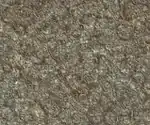 False-color Mars Reconnaissance Orbiter image of polygonal surface pattern.
False-color Mars Reconnaissance Orbiter image of polygonal surface pattern.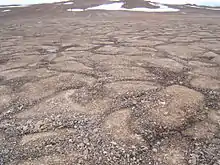 Patterned ground on earth.
Patterned ground on earth.
Other issues
The International Permafrost Association (IPA) is an integrator of issues regarding permafrost. It convenes International Permafrost Conferences, undertakes special projects such as preparing databases, maps, bibliographies, and glossaries, and coordinates international field programmes and networks. Among other issues addressed by the IPA are: Problems for construction on permafrost owing to the change of soil properties of the ground on which structures are placed and the biological processes in permafrost, e.g. the preservation of organisms frozen in situ.
Construction on permafrost
Yakutsk is one of two large cities in the world built in areas of continuous permafrost—that is, where the frozen soil forms an unbroken, below-zero sheet. The other is Norilsk, in Krasnoyarsk Krai, Russia.[109]
Building on permafrost is difficult because the heat of the building (or pipeline) can warm the permafrost and destabilize the structure. Warming can result in thawing of the soil and its consequent weakening of support for a structure as the ice content turns to water; alternatively, where structures are built on piles, warming can cause movement through creep because of the change of friction on the piles even as the soil remains frozen.[110]
Three common solutions include: using foundations on wood piles, a technique pioneered by Soviet engineer Mikhail Kim in Norilsk;[111] building on a thick gravel pad (usually 1–2 metres/3.3–6.6 feet thick); or using anhydrous ammonia heat pipes.[112] The Trans-Alaska Pipeline System uses heat pipes built into vertical supports to prevent the pipeline from sinking and the Qingzang railway in Tibet employs a variety of methods to keep the ground cool, both in areas with frost-susceptible soil. Permafrost may necessitate special enclosures for buried utilities, called "utilidors".[113]
The Melnikov Permafrost Institute in Yakutsk, found that the sinking of large buildings into the ground can be prevented by using pile foundations extending down to 15 metres (49 ft) or more. At this depth the temperature does not change with the seasons, remaining at about −5 °C (23 °F).[114]
Thawing permafrost represents a threat to industrial infrastructure. In May 2020 thawing permafrost at Norilsk-Taimyr Energy's Thermal Power Plant No. 3 caused an oil storage tank to collapse, spilling 6,000 tonnes of diesel into the land, 15,000 into the water. The rivers Ambarnaya, Daldykan and many smaller rivers were polluted. The pollution reached the lake Pyasino that is important to the water supply of the entire Taimyr Peninsula. State of emergency at the federal level was declared. Many buildings and infrastructure are built on permafrost, which cover 65% of Russian territory, and all those can be damaged as it thaws. [115][116] The 2020 Norilsk oil spill has been described as the second-largest oil spill in modern Russian history.[117] The thawing can also cause leakage of toxic elements from sites of buried toxic waste.[117][118]
There is no ground water available in an area underlain with permafrost. Any substantial settlement or installation needs to make some alternative arrangement to obtain water.[109]
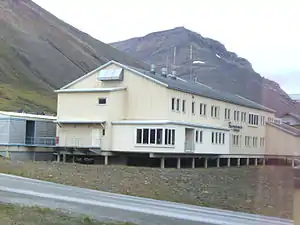 Modern buildings in permafrost zones may be built on piles to avoid permafrost-thaw foundation failure from the heat of the building.
Modern buildings in permafrost zones may be built on piles to avoid permafrost-thaw foundation failure from the heat of the building..jpg.webp) Heat pipes in vertical supports maintain a frozen bulb around portions of the Trans-Alaska Pipeline that are at risk of thawing.
Heat pipes in vertical supports maintain a frozen bulb around portions of the Trans-Alaska Pipeline that are at risk of thawing.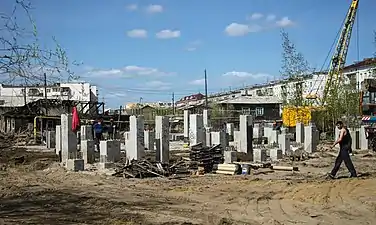 Pile foundations in Yakutsk, a city underlain with continuous permafrost.
Pile foundations in Yakutsk, a city underlain with continuous permafrost.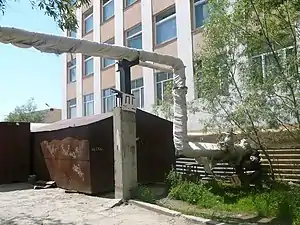 District heating pipes run above ground in Yakutsk to avoid thawing permafrost.
District heating pipes run above ground in Yakutsk to avoid thawing permafrost.
See also
- Global Terrestrial Network for Permafrost
- Pleistocene & Permafrost Foundation
References
- Obu, J. (2021). "How Much of the Earth's Surface is Underlain by Permafrost?". Journal of Geophysical Research: Earth Surface. 126 (5): e2021JF006123. Bibcode:2021JGRF..12606123O. doi:10.1029/2021JF006123. ISSN 2169-9011.
- Sayedi, Sayedeh Sara; Abbott, Benjamin W; Thornton, Brett F; Frederick, Jennifer M; Vonk, Jorien E; Overduin, Paul; Schädel, Christina; Schuur, Edward A G; Bourbonnais, Annie; Demidov, Nikita; Gavrilov, Anatoly (1 December 2020). "Subsea permafrost carbon stocks and climate change sensitivity estimated by expert assessment". Environmental Research Letters. 15 (12): B027-08. Bibcode:2020AGUFMB027...08S. doi:10.1088/1748-9326/abcc29. ISSN 1748-9326. S2CID 234515282.
- Doyle, Heather (9 April 2020). "What Is Permafrost?". NASA Climate Kids. Retrieved 16 April 2020.
- Koven, Charles D. (2011). "Permafrost carbon-climate feedbacks accelerate global warming". Proceedings of the National Academy of Sciences. 108 (36): 14769–14774.
- Fox-Kemper, B.; Hewitt, H.T.; Xiao, C.; Aðalgeirsdóttir, G.; Drijfhout, S.S.; Edwards, T.L.; Golledge, N.R.; Hemer, M.; Kopp, R.E.; Krinner, G.; Mix, A. (2021). Masson-Delmotte, V.; Zhai, P.; Pirani, A.; Connors, S.L.; Péan, C.; Berger, S.; Caud, N.; Chen, Y.; Goldfarb, L. (eds.). "Ocean, Cryosphere and Sea Level Change". Climate Change 2021: The Physical Science Basis. Contribution of Working Group I to the Sixth Assessment Report of the Intergovernmental Panel on Climate Change. Cambridge University Press, Cambridge, UK and New York, NY, USA: 1237, 1238–1239, 1320. doi:10.1017/9781009157896.011 (inactive 9 July 2022).
{{cite journal}}: CS1 maint: DOI inactive as of July 2022 (link) - King, Lorenz (2001). "Materialien zur Kenntniss des unvergänglichen Boden-Eises in Sibirien, compiled by Baer in 1843" (PDF). Berichte und Arbeiten aus der Universitätsbibliothek und dem Universitätsarchiv Giessen (in German). 51: 1–315. Retrieved 27 July 2021.
- Walker, H. Jesse (December 2010). "Frozen in Time. Permafrost and Engineering Problems Review". Arctic. 63 (4): 477. doi:10.14430/arctic3340. Archived from the original on 6 January 2015. Retrieved 19 November 2018.
- Ray, Luis L. "Permafrost - USGS [=United States Geological Survey] Library Publications Warehouse" (PDF). Archived (PDF) from the original on 2 May 2017. Retrieved 19 November 2018.
- U.S. Geological Survey; United States. Army. Corps of Engineers. Strategic Intelligence Branch (1943). "Permafrost or permanently frozen ground and related engineering problems". Strategic Engineering Study (62): 231. OCLC 22879846.
{{cite journal}}: CS1 maint: multiple names: authors list (link) - Occurrences on Google Books.
- Muller, Siemon William (1947). Permafrost. Or, Permanently Frozen Ground and Related Engineering Problems. Ann Arbor, Michigan: Edwards. ISBN 9780598538581. OCLC 1646047.
- Staff (2014). "What is Permafrost?". International Permafrost Association. Archived from the original on 8 November 2014. Retrieved 28 February 2014.
- Brown, J.; Ferrians, O. J. Jr.; Heginbottom, J. A.; Melnikov, E. S. (1997). "Circum-Arctic map of permafrost and ground-ice conditions". Circum-Pacific Map. doi:10.3133/cp45.
- Heginbottom, J. Alan, Brown, Jerry; Humlum, Ole and Svensson, Harald; ‘State of the Earth’s Cryosphere at the Beginning of the 21st Century: Glaciers, Global Snow Cover, Floating Ice, and Permafrost and Periglacial Environments’, p. A435
- Delisle, G. (2007). "Near-surface permafrost degradation: How severe during the 21st century?". Geophysical Research Letters. 34 (L09503): 4. Bibcode:2007GeoRL..34.9503D. doi:10.1029/2007GL029323.
- Sharp, Robert Phillip (1988). Living Ice: Understanding Glaciers and Glaciation. Cambridge University Press. p. 27. ISBN 978-0-521-33009-1.
- Majorowicz, Jacek (2012), "Permafrost at the ice base of recent pleistocene glaciations – Inferences from borehole temperatures profiles", Bulletin of Geography. Physical Geography Series, Physical Geography Series, 5: 7–28, doi:10.2478/v10250-012-0001-x
- Brown, Roger J.E.; Péwé, Troy L. (1973), "Distribution of permafrost in North America and its relationship to the environment: A review, 1963–1973", Permafrost: North American Contribution – Second International Conference, 2: 71–100, ISBN 9780309021159
- Robinson, S.D.; et al. (2003), "Permafrost and peatland carbon sink capacity with increasing latitude", in Phillips; et al. (eds.), Permafrost (PDF), Swets & Zeitlinger, pp. 965–970, ISBN 90-5809-582-7, archived (PDF) from the original on 2 March 2014, retrieved 2 March 2014
- Bockheim, James G.; Munroe, Jeffrey S. (2014), "Organic carbon pools and genesis of alpine soils with permafrost: a review" (PDF), Arctic, Antarctic, and Alpine Research, 46 (4): 987–1006, doi:10.1657/1938-4246-46.4.987, S2CID 53400041, archived (PDF) from the original on 23 September 2016, retrieved 25 April 2016
- Andersland, Orlando B.; Ladanyi, Branko (2004). Frozen ground engineering (2nd ed.). Wiley. p. 5. ISBN 978-0-471-61549-1.
- Zoltikov, I.A. (1962), "Heat regime of the central Antarctic glacier", Antarctica, Reports of the Commission, 1961 (in Russian): 27–40
- Campbell, Iain B.; Claridge, Graeme G. C. (2009), "Antarctic Permafrost Soils", in Margesin, Rosa (ed.), Permafrost Soils, Soil Biology, vol. 16, Berlin: Springer, pp. 17–31, doi:10.1007/978-3-540-69371-0_2, ISBN 978-3-540-69370-3
- Heinrich, Holly (25 July 2013), "Permafrost Melting Faster Than Expected in Antarctica", National Public Radio, archived from the original on 3 May 2016, retrieved 23 April 2016
- "Alpine permafrost". Encyclopedia Britannica. Retrieved 16 April 2020.
- Azocar, Guillermo (2014), Modeling of Permafrost Distribution in the Semi-arid Chilean Andes, Waterloo, Ontario: University of Waterloo, archived from the original on 30 May 2016, retrieved 24 April 2016
- Ruiz, Lucas; Liaudat, Dario Trombotto (2012), Mountain Permafrost Distribution in the Andes of Chubut (Argentina) Based on a Statistical Model (PDF), Tenth International Conference on Permafrost, Mendoza, Argentina: Instituto Argentino de Nivología Glaciología y Ciencias Ambientales, pp. 365–370, archived (PDF) from the original on 13 May 2016, retrieved 24 April 2016
- Rozell, Ned (18 November 2009), "Permafrost near equator; hummingbirds near subarctic", Capitol City Weekly, Juneau, Alaska, archived from the original on 5 March 2018
- "What is Permafrost?". International Permafrost Association. 2014. Archived from the original on 8 November 2014. Retrieved 8 November 2014.
- Osterkamp, T. E. (2001), "Sub-Sea Permafrost", Encyclopedia of Ocean Sciences, pp. 2902–12, doi:10.1006/rwos.2001.0008, ISBN 9780122274305
- IPCC AR4 (2007). "Climate Change 2007: Working Group I: The Physical Science Basis". Archived from the original on 13 April 2014. Retrieved 12 April 2014.
{{cite web}}: CS1 maint: uses authors parameter (link) - Sayedi, Sayedeh Sara; Abbott, Benjamin W; Thornton, Brett F; Frederick, Jennifer M; Vonk, Jorien E; Overduin, Paul; Schädel, Christina; Schuur, Edward A G; Bourbonnais, Annie; Demidov, Nikita; Gavrilov, Anatoly (1 December 2020). "Subsea permafrost carbon stocks and climate change sensitivity estimated by expert assessment". Environmental Research Letters. 15 (12): 124075. Bibcode:2020AGUFMB027...08S. doi:10.1088/1748-9326/abcc29. ISSN 1748-9326.
- Overduin, P. P.; Schneider von Deimling, T.; Miesner, F.; Grigoriev, M. N.; Ruppel, C.; Vasiliev, A.; Lantuit, H.; Juhls, B.; Westermann, S. (June 2019). "Submarine Permafrost Map in the Arctic Modeled Using 1‐D Transient Heat Flux (SuPerMAP)". Journal of Geophysical Research: Oceans. 124 (6): 3490–3507. Bibcode:2019JGRC..124.3490O. doi:10.1029/2018JC014675. hdl:1912/24566. ISSN 2169-9275. S2CID 146331663.
- IPCC AR6 WG1 Ch9 2021, p.1281
- Lunardini 1995, p. 35 Table Dl. Freeze at Prudhoe Bay, Alaska.
- Osterkamp, T.E.; Burn, C.R. (14 September 2014), "Permafrost", in North, Gerald R.; Pyle, John A.; Zhang, Fuqing (eds.), Encyclopedia of Atmospheric Sciences (PDF), vol. 4, Elsevier, pp. 1717–1729, ISBN 978-0123822260, archived (PDF) from the original on 30 November 2016, retrieved 8 March 2016
- Desonie, Dana (2008). Polar Regions: Human Impacts. New York: Chelsea Press. ISBN 978-0-8160-6218-8.
- Fridleifsson, Ingvar B.; Bertani, Ruggero; Huenges, Ernst; Lund, John W.; Ragnarsson, Arni; Rybach, Ladislaus (11 February 2008). O. Hohmeyer and T. Trittin (ed.). "The possible role and contribution of geothermal energy to the mitigation of climate change" (PDF). IPCC Scoping Meeting on Renewable Energy Sources, Luebeck, Germany: 59–80. Archived from the original (PDF) on 12 March 2013. Retrieved 3 November 2013.
{{cite journal}}: Cite journal requires|journal=(help) - Lunardini, Virgil J. (April 1995). "Permafrost Formation Time". CRREL Report 95-8. Hanover NH: US Army Corps of Engineers Cold Regions Research and Engineering Laboratory. p. 18. ADA295515. Archived from the original (PDF) on 8 April 2013. Retrieved 3 March 2012.
- Mackay, J. Ross (1973), "Problems in the origins of massive icy beds, Western Arctic, Canada", Permafrost: North American Contribution – Second International Conference, 2: 223–8, ISBN 9780309021159
- French, H.M. (2007). The Periglacial Environment (3 ed.). Chichester: Wiley.
- Shumskiy, P.A.; Vtyurin, B.I. (1963), "Underground ice", Permafrost International Conference (1287): 108–13
- Mackay, J.R.; Dallimore, S.R. (1992), "Massive ice of Tuktoyaktuk area, Western Arctic coast, Canada", Canadian Journal of Earth Sciences, 29 (6): 1234–42, Bibcode:1992CaJES..29.1235M, doi:10.1139/e92-099
- Astakhov, 1986; Kaplanskaya and Tarnogradskiy, 1986; Astakhov and Isayeva, 1988; French, 1990; Lacelle et al., 2009
- Pidwirny, M (2006). "Periglacial Processes and Landforms". Fundamentals of Physical Geography.
- Kessler MA, Werner BT (January 2003). "Self-organization of sorted patterned ground". Science. 299 (5605): 380–3. Bibcode:2003Sci...299..380K. doi:10.1126/science.1077309. PMID 12532013. S2CID 27238820.
- Li, Dongfeng; Overeem, Irina; Kettner, Albert J.; Zhou, Yinjun; Lu, Xixi (February 2021). "Air Temperature Regulates Erodible Landscape, Water, and Sediment Fluxes in the Permafrost‐Dominated Catchment on the Tibetan Plateau". Water Resources Research. 57 (2): e2020WR028193. Bibcode:2021WRR....5728193L. doi:10.1029/2020WR028193. ISSN 0043-1397. S2CID 234044271.
- Zhang, Ting; Li, Dongfeng; Kettner, Albert J.; Zhou, Yinjun; Lu, Xixi (October 2021). "Constraining Dynamic Sediment‐Discharge Relationships in Cold Environments: The Sediment‐Availability‐Transport (SAT) Model". Water Resources Research. 57 (10): e2021WR030690. Bibcode:2021WRR....5730690Z. doi:10.1029/2021WR030690. ISSN 0043-1397. S2CID 242360211.
- McGuire, A.D., Anderson, L.G., Christensen, T.R., Dallimore, S., Guo, L., Hayes, D.J., Heimann, M., Lorenson, T.D., Macdonald, R.W., and Roulet, N. (2009). "Sensitivity of the carbon cycle in the Arctic to climate change". Ecological Monographs. 79 (4): 523–555. doi:10.1890/08-2025.1. hdl:11858/00-001M-0000-000E-D87B-C. S2CID 1779296.
{{cite journal}}: CS1 maint: multiple names: authors list (link) - IPCC AR6 WG1 Ch9 2021, p. 9-8, 1280
- Koven, Charles D.; Riley, William J.; Stern, Alex (1 October 2012). "Analysis of Permafrost Thermal Dynamics and Response to Climate Change in the CMIP5 Earth System Models". Journal of Climate. 26 (6): 1877–1900. doi:10.1175/JCLI-D-12-00228.1. ISSN 0894-8755. OSTI 1172703.
- Armstrong McKay, David I.; Staal, Arie; Abrams, Jesse F.; Winkelmann, Ricarda; Sakschewski, Boris; Loriani, Sina; Fetzer, Ingo; Cornell, Sarah E.; Rockström, Johan; Lenton, Timothy M. (9 September 2022). "Exceeding 1.5°C global warming could trigger multiple climate tipping points". Science. 377 (6611): eabn7950. doi:10.1126/science.abn7950. ISSN 0036-8075.
- Nelson, F. E.; Anisimov, O. A.; Shiklomanov, N. I. (1 July 2002). "Climate Change and Hazard Zonation in the Circum-Arctic Permafrost Regions". Natural Hazards. 26 (3): 203–225. doi:10.1023/A:1015612918401. ISSN 1573-0840. S2CID 35672358.
- Barry, Roger Graham; Gan, Thian-Yew (2021). The global cryosphere past, present and future (Second revised ed.). Cambridge, United Kingdom. ISBN 978-1-108-48755-9. OCLC 1256406954.
- The Natural Fix?: The Role of Ecosystems in Climate Mitigation UNEP 2009 page. 20, 55
- Sidorchuk, Aleksey, Borisova Olga and Panin; Andrey; “Fluvial response to the late Valdai/Holocene environmental change on the East European plain” Archived 2013-12-26 at the Wayback Machine
- Yugo Ono and Tomohisa Irino; “Southern migration of westerlies in the Northern Hemisphere PEP II transect during the Last Glacial Maximum” in Quaternary International 118–119 (2004); pp. 13–22
- Malde, H.E.; “Patterned Ground in the Western Snake River Plain, Idaho, and Its Possible Cold-Climate Origin”; in Geological society of America Bulletin; v. 75 no. 3 (March 1964); pp. 191–208
- Grab, Stefan; “Characteristics and palaeoenvironmental significance of relict sorted patterned ground, Drakensberg plateau, southern Africa” in Quaternary Science Reviews, vol. 21, issues 14–15, (August 2002), pp. 1729–1744
- "Inventory of fossil cryogenic forms and structures in Patagonia and the mountains of Argentina beyond the Andes". South African Journal of Science, 98: 171–180, Review Articles, Pretoria, Sudáfrica.
- Kim, D; Vargas, R; Bond-Lamberty, B; Turetsky, M (2012). "Effects of soil rewetting and thawing on soil gas fluxes: a review of current literature and suggestions for future research". Biogeosciences. 9 (7): 2459–2483. Bibcode:2012BGeo....9.2459K. doi:10.5194/bg-9-2459-2012.
- Huissteden, J. van (2020). Thawing Permafrost: Permafrost Carbon in a Warming Arctic. Springer Nature. p. 296. ISBN 978-3-030-31379-1.
- Larry D. Dyke, Wendy E. Sladen (2010). "Permafrost and Peatland Evolution in the Northern Hudson Bay Lowland, Manitoba". Arctic. 63 (4). doi:10.14430/arctic3332. Archived from the original on 10 August 2014. Retrieved 2 August 2014.
{{cite journal}}: CS1 maint: uses authors parameter (link) - F., Dramis; M., Govi; M., Guglielmin; G., Mortara (1 January 1995). "Mountain permafrost and slope instability in the Italian Alps: The Val Pola Landslide". Permafrost and Periglacial Processes. 6 (1): 73–81. doi:10.1002/ppp.3430060108. ISSN 1099-1530.
- Huggel, C.; Allen, S.; Deline, P.; et al. (June 2012), "Ice thawing, mountains falling; are alpine rock slope failures increasing?", Geology Today, 28 (3): 98–104, doi:10.1111/j.1365-2451.2012.00836.x, S2CID 128619284
- McSaveney, M.J. (2002). Recent rockfalls and rock avalanches in Mount Cook national park, New Zealand. In Catastrophic landslides, effects, occurrence and mechanisms. Boulder: Geological Society of America, Reviews in Engineering Geology, Volume XV. pp. 35–70. ISBN 9780813758152. Archived from the original on 28 January 2018. Retrieved 27 January 2018.
- Nater, P.; Arenson, L.U.; Springman, S.M. (2008). Choosing geotechnical parameters for slope stability assessments in alpine permafrost soils. In 9th international conference on permafrost. Fairbanks, USA: University of Alaska. pp. 1261–1266. ISBN 9780980017939.
- Kia, Mohammadali; Sego, David Charles; Morgenstern, Norbert Rubin. "FRP: Filter-less Rigid Piezometer for Measuring Pore-Water Pressure in Partially Frozen Soils". Alpha Adroit Engineering Ltd. Alpha Adroit Engineering Ltd. Archived from the original on 28 January 2018. Retrieved 27 January 2018.
- Temme, Arnaud J. A. M. (2015). "Using Climber's Guidebooks to Assess Rock Fall Patterns Over Large Spatial and Decadal Temporal Scales: An Example from the Swiss Alps". Geografiska Annaler: Series A, Physical Geography. 97 (4): 793–807. doi:10.1111/geoa.12116. ISSN 1468-0459. S2CID 55361904.
- "FDL: Frozen Debris Lobes". University of Alaska Fairbanks. FDLs. 7 January 2022. Retrieved 7 January 2022.
- Hasemyer, David (20 December 2021). "Unleashed by Warming, Underground Debris Fields Threaten to 'Crush' Alaska's Dalton Highway and the Alaska Pipeline". Inside Climate News. Retrieved 7 January 2022.
- Daanen, Ronald; Grosse, Guido; Darrow, Margaret; Hamilton, T.; Jones, Benjamin (21 May 2012). "Rapid movement of frozen debris-lobes: Implications for permafrost degradation and slope instability in the south-central Brooks Range, Alaska". Natural Hazards and Earth System Sciences. 12 (5): 1521–1537. Bibcode:2012NHESS..12.1521D. doi:10.5194/nhess-12-1521-2012.
- Darrow, Margaret; Gyswyt, N.; Simpson, J.; Daanen, Ronald; Hubbard, T.; et al. (May 2016). "Frozen debris lobe morphology and movement: an overview of eight dynamic features, southern Brooks Range, Alaska" (PDF). The Cryosphere. 10 (3): 977–993. Bibcode:2016TCry...10..977D. doi:10.5194/tc-10-977-2016.
- Tarnocai; et al. (2009). "Soil organic carbon pools in the northern circumpolar permafrost region". Global Biogeochemical Cycles. 23 (2): GB2023. Bibcode:2009GBioC..23.2023T. doi:10.1029/2008gb003327.
- Schuur; et al. (2011). "High risk of permafrost thaw". Nature. 480 (7375): 32–33. Bibcode:2011Natur.480...32S. doi:10.1038/480032a. PMID 22129707. S2CID 4412175.
- Walter KM, Zimov SA, Chanton JP, Verbyla D, Chapin FS (September 2006). "Methane bubbling from Siberian thaw lakes as a positive feedback to climate warming". Nature. 443 (7107): 71–5. Bibcode:2006Natur.443...71W. doi:10.1038/nature05040. PMID 16957728. S2CID 4415304.
- C. Michael Hogan, Black Spruce: Picea mariana, GlobalTwitcher.com, ed. Nicklas Stromberg, November, 2008 Archived 2011-10-05 at the Wayback Machine
- Hansen; et al. (2007). "Viability, diversity and composition of the bacterial community in a high Arctic permafrost soil from Spitsbergen, Northern Norway". Environmental Microbiology. 9 (11): 2870–2884. doi:10.1111/j.1462-2920.2007.01403.x. PMID 17922769. – and additional references in this paper. Yergeau; et al. (2010). "The functional potential of high Arctic permafrost revealed by metagenomic sequencing, qPCR and microarray analyses". The ISME Journal. 4 (9): 1206–1214. doi:10.1038/ismej.2010.41. PMID 20393573.
- Li, Dongfeng; Lu, Xixi; Overeem, Irina; Walling, Desmond E.; Syvitski, Jaia; Kettner, Albert J.; Bookhagen, Bodo; Zhou, Yinjun; Zhang, Ting (29 October 2021). "Exceptional increases in fluvial sediment fluxes in a warmer and wetter High Mountain Asia". Science. 374 (6567): 599–603. Bibcode:2021Sci...374..599L. doi:10.1126/science.abi9649. ISSN 0036-8075. PMID 34709922. S2CID 240152765.
- IPCC AR6 WG1 Ch9 2021, p. 1283
- Fox-Kemper, B.; Hewitt, H.T.; Xiao, C.; Aðalgeirsdóttir, G.; Drijfhout, S.S.; Edwards, T.L.; Golledge, N.R.; Hemer, M.; Kopp, R.E.; Krinner, G.; Mix, A. (2021). Masson-Delmotte, V.; Zhai, P.; Pirani, A.; Connors, S.L.; Péan, C.; Berger, S.; Caud, N.; Chen, Y.; Goldfarb, L. (eds.). "Ocean, Cryosphere and Sea Level Change". Climate Change 2021: The Physical Science Basis. Contribution of Working Group I to the Sixth Assessment Report of the Intergovernmental Panel on Climate Change. Cambridge University Press, Cambridge, UK and New York, NY, USA. 2021: 1237, 1238–1239, 1320. Bibcode:2021AGUFM.U13B..09F. doi:10.1017/9781009157896.011 (inactive 31 July 2022).
{{cite journal}}: CS1 maint: DOI inactive as of July 2022 (link) - "Working Group I Contribution to the IPCC Fifth Assessment Report Climate Change 2013 - Summary for Policymakers - Template Lab". 10 November 2015. Archived from the original on 18 January 2017. Retrieved 16 January 2017.
- Douglas, Thomas A.; Turetsky, Merritt R.; Koven, Charles D. (24 July 2020). "Increased rainfall stimulates permafrost thaw across a variety of Interior Alaskan boreal ecosystems". NPJ Climate and Atmospheric Science. 3 (1): 5626. doi:10.1038/s41467-022-33293-x. PMC 9512808. PMID 36163194.
- Nowinski NS, Taneva L, Trumbore SE, Welker JM (January 2010). "Decomposition of old organic matter as a result of deeper active layers in a snow depth manipulation experiment". Oecologia. 163 (3): 785–92. Bibcode:2010Oecol.163..785N. doi:10.1007/s00442-009-1556-x. PMC 2886135. PMID 20084398.
- Schuur, E.A.G., Bockheim, J., Canadell, J.G., Euskirchen, E., Field, C.B., Goryachkin, S.V., Hagemann, S., Kuhry, P., Lafleur, P.M., Lee, H., Mazhitova, G., Nelson, F.E., Rinke, A., Romanovsky, V.E., Skiklomanov, N., Tarnocai, C., Venevsky, S., Vogel, J.G., and Zimov, S.A. (2008). "Vulnerability of Permafrost Carbon to Climate Change: Implications for the Global Carbon Cycle". BioScience. 58 (8): 701–714. doi:10.1641/B580807.
{{cite journal}}: CS1 maint: multiple names: authors list (link) - Lim, Artem G.; Loiko, Sergey V.; Pokrovsky, Oleg S. (10 January 2023). "Interactions between organic matter and Fe oxides at soil micro-interfaces: Quantification, associations, and influencing factors". Science of the Total Environment. 3: 158710. Bibcode:2023ScTEn.855o8710L. doi:10.1016/j.scitotenv.2022.158710. S2CID 252221350.
- Patzner, Monique S.; Mueller, Carsten W.; Malusova, Miroslava; Baur, Moritz; Nikeleit, Verena; Scholten, Thomas; Hoeschen, Carmen; Byrne, James M.; Borch, Thomas; Kappler, Andreas; Bryce, Casey (10 December 2020). "Iron mineral dissolution releases iron and associated organic carbon during permafrost thaw". Nature Communications. 11 (1): 6329. Bibcode:2020NatCo..11.6329P. doi:10.1038/s41467-020-20102-6. PMC 7729879. PMID 33303752.
- Bockheim, J.G. & Hinkel, K.M. (2007). "The importance of "Deep" organic carbon in permafrost-affected soils of Arctic Alaska". Soil Science Society of America Journal. 71 (6): 1889–92. Bibcode:2007SSASJ..71.1889B. doi:10.2136/sssaj2007.0070N. Archived from the original on 17 July 2009. Retrieved 5 June 2010.
- Li, Qi; Hu, Weifang; Li, Linfeng; Li, Yichun (1 March 2022). "Sizable pool of labile organic carbon in peat and mineral soils of permafrost peatlands, western Siberia". Geoderma. 3 (1): 5626. doi:10.1038/s41467-022-33293-x. PMC 9512808. PMID 36163194.
- Gillis, Justin (16 December 2011). "As Permafrost Thaws, Scientists Study the Risks". The New York Times. Archived from the original on 19 May 2017. Retrieved 11 February 2017.
- Schellnhuber, Hans Joachim; Winkelmann, Ricarda; Scheffer, Marten; Lade, Steven J.; Fetzer, Ingo; Donges, Jonathan F.; Crucifix, Michel; Cornell, Sarah E.; Barnosky, Anthony D. (2018). "Trajectories of the Earth System in the Anthropocene". Proceedings of the National Academy of Sciences. 115 (33): 8252–8259. Bibcode:2018PNAS..115.8252S. doi:10.1073/pnas.1810141115. ISSN 0027-8424. PMC 6099852. PMID 30082409.
- MacDougall, Andrew H. (10 September 2021). "Estimated effect of the permafrost carbon feedback on the zero emissions commitment to climate change". Biogeosciences. 18 (17): 4937–4952. Bibcode:2021BGeo...18.4937M. doi:10.5194/bg-18-4937-2021.
- Sayedi, Sayedeh Sara; Abbott, Benjamin W; Thornton, Brett F; Frederick, Jennifer M; Vonk, Jorien E; Overduin, Paul; Schädel, Christina; Schuur, Edward A G; Bourbonnais, Annie; Demidov, Nikita; Gavrilov, Anatoly (1 December 2020). "Subsea permafrost carbon stocks and climate change sensitivity estimated by expert assessment". Environmental Research Letters. 15 (12): B027-08. Bibcode:2020AGUFMB027...08S. doi:10.1088/1748-9326/abcc29. ISSN 1748-9326. S2CID 234515282.
- Hugelius, Gustaf; Loisel, Julie; Chadburn, Sarah; et al. (10 August 2020). "Large stocks of peatland carbon and nitrogen are vulnerable to permafrost thaw". Earth, Atmospheric, and Planetary Sciences. 117 (34): 20438–20446. Bibcode:2020PNAS..11720438H. doi:10.1073/pnas.1916387117. PMC 7456150. PMID 32778585.
- Dietz, Simon; Rising, James; Stoerk, Thomas; Wagner, Gernot (24 August 2021). "Economic impacts of tipping points in the climate system". Proceedings of the National Academy of Sciences. 118 (34): e2103081118. Bibcode:2021PNAS..11803081D. doi:10.1073/pnas.2103081118. PMC 8403967. PMID 34400500.
- Keen, Steve; Lenton, Timothy M.; Garrett, Timothy J.; Rae, James W. B.; Hanley, Brian P.; Grasselli, Matheus (19 May 2022). "Estimates of economic and environmental damages from tipping points cannot be reconciled with the scientific literature". Proceedings of the National Academy of Sciences. 119 (21): e2117308119. Bibcode:2022PNAS..11917308K. doi:10.1073/pnas.2117308119. S2CID 248917625.
- Dietz, Simon; Rising, James; Stoerk, Thomas; Wagner, Gernot (19 May 2022). "Reply to Keen et al.: Dietz et al. modeling of climate tipping points is informative even if estimates are a probable lower bound". Proceedings of the National Academy of Sciences. 119 (21): e2201191119. Bibcode:2022PNAS..11901191D. doi:10.1073/pnas.2201191119. PMC 9173815. PMID 35588452.
- "Carbon Emissions from Permafrost". 50x30. 2021. Retrieved 8 October 2022.
- Natali, Susan M.; Holdren, John P.; Rogers, Brendan M.; Treharne, Rachael; Duffy, Philip B.; Pomerance, Rafe; MacDonald, Erin (10 December 2020). "Permafrost carbon feedbacks threaten global climate goals". Biological Sciences. 118 (21). doi:10.1073/pnas.2100163118. PMC 8166174. PMID 34001617.
- Armstrong McKay, David; Abrams, Jesse; Winkelmann, Ricarda; Sakschewski, Boris; Loriani, Sina; Fetzer, Ingo; Cornell, Sarah; Rockström, Johan; Staal, Arie; Lenton, Timothy (9 September 2022). "Exceeding 1.5°C global warming could trigger multiple climate tipping points". Science. 377 (6611): eabn7950. doi:10.1126/science.abn7950. ISSN 0036-8075. PMID 36074831. S2CID 252161375.
- Armstrong McKay, David (9 September 2022). "Exceeding 1.5°C global warming could trigger multiple climate tipping points – paper explainer". climatetippingpoints.info. Retrieved 2 October 2022.
- Smith, Alvin W.; Skilling, Douglas E.; Castello, John D.; Rogers, Scott O. (1 January 2004). "Ice as a reservoir for pathogenic human viruses: specifically, caliciviruses, influenza viruses, and enteroviruses". Medical Hypotheses. 63 (4): 560–566. doi:10.1016/j.mehy.2004.05.011. ISSN 0306-9877. PMID 15324997.
- Frey, Beat; Rime, Thomas; Phillips, Marcia; Stierli, Beat; Hajdas, Irka; Widmer, Franco; Hartmann, Martin (March 2016). Margesin, Rosa (ed.). "Microbial diversity in European alpine permafrost and active layers". FEMS Microbiology Ecology. 92 (3): fiw018. doi:10.1093/femsec/fiw018. ISSN 1574-6941. PMID 26832204.
- "Anthrax Outbreak In Russia Thought To Be Result Of Thawing Permafrost". NPR.org. Archived from the original on 22 September 2016. Retrieved 24 September 2016.
- Legendre, Matthieu; Bartoli, Julia; Shmakova, Lyubov; Jeudy, Sandra; Labadie, Karine; Adrait, Annie; Lescot, Magali; Poirot, Olivier; Bertaux, Lionel; Bruley, Christophe; Couté, Yohann (2014). "Thirty-thousand-year-old distant relative of giant icosahedral DNA viruses with a pandoravirus morphology". Proceedings of the National Academy of Sciences of the United States of America. 111 (11): 4274–4279. Bibcode:2014PNAS..111.4274L. doi:10.1073/pnas.1320670111. ISSN 0027-8424. JSTOR 23771019. PMC 3964051. PMID 24591590.
- Legendre, Matthieu; Lartigue, Audrey; Bertaux, Lionel; Jeudy, Sandra; Bartoli, Julia; Lescot, Magali; Alempic, Jean-Marie; Ramus, Claire; Bruley, Christophe; Labadie, Karine; Shmakova, Lyubov (2015). "In-depth study of Mollivirus sibericum, a new 30,000-y-old giant virus infecting Acanthamoeba". Proceedings of the National Academy of Sciences of the United States of America. 112 (38): E5327–E5335. Bibcode:2015PNAS..112E5327L. doi:10.1073/pnas.1510795112. ISSN 0027-8424. JSTOR 26465169. PMC 4586845. PMID 26351664.
- Kudryashova, E. B.; Chernousova, E. Yu.; Suzina, N. E.; Ariskina, E. V.; Gilichinsky, D. A. (1 May 2013). "Microbial diversity of Late Pleistocene Siberian permafrost samples". Microbiology. 82 (3): 341–351. doi:10.1134/S0026261713020082. ISSN 1608-3237. S2CID 2645648.
- Isachenkov, Vladimir (20 February 2012), "Russians revive Ice Age flower from frozen burrow", Phys.Org, archived from the original on 24 April 2016, retrieved 26 April 2016
- Joshua Yaffa (20 January 2022). "The Great Siberian Thaw". The New Yorker. Retrieved 20 January 2022.
- Fang, Hsai-Yang (31 December 1990). Foundation Engineering Handbook. Springer Science & Business Media. p. 735. ISBN 978-0-412-98891-2.
- Yaffa, Joshua (7 January 2022). "The Great Siberian Thaw". The New Yorker. Retrieved 12 January 2022.
- Clarke, Edwin S. (2007). Permafrost Foundations—State of the Practice. Monograph Series. American Society of Civil Engineers. ISBN 978-0-7844-0947-3.
- Woods, Kenneth B. (1966). Permafrost International Conference: Proceedings. National Academies. pp. 418–57.
- Sanger, Frederick J.; Hyde, Peter J. (1 January 1978). Permafrost: Second International Conference, July 13-28, 1973 : USSR Contribution. National Academies. p. 786. ISBN 9780309027465.
- "Diesel fuel spill in Norilsk in Russia's Arctic contained". TASS. Moscow, Russia. 5 June 2020. Retrieved 7 June 2020.
- Max Seddon (4 June 2020), "Siberia fuel spill threatens Moscow's Arctic ambitions", Financial Times
- Ivan Nechepurenko (5 June 2020), "Russia Declares Emergency After Arctic Oil Spill", New York Times
- ANTONOVA, MARIA (5 June 2020). "Russia Says Melting Permafrost Is Behind The Massive Arctic Fuel Spill". Science Daily. Retrieved 19 July 2020.
Sources
- Fox-Kemper, Baylor; Hewitt, Helene T.; Xiao, Cunde; Aðalgeirsdóttir, Guðfinna; et al. (2021). "Chapter 9: Ocean, cryosphere, and sea level change" (PDF). IPCC AR6 WG1 2021.
- IPCC (2021). Masson-Delmotte, V.; Zhai, P.; Pirani, A.; Connors, S. L.; et al. (eds.). Climate Change 2021: The Physical Science Basis (PDF). Contribution of Working Group I to the Sixth Assessment Report of the Intergovernmental Panel on Climate Change. Cambridge University Press (In Press).
External links
- Permafrostwatch University of Alaska Fairbanks
- Infographics about permafrost
- International Permafrost Association (IPA)
- Alpine permafrost monitoring network - permanet
- Center for Permafrost
- Map of permafrost in Antarctica.
- Permafrost – what is it? – YouTube (Alfred Wegener Institute)